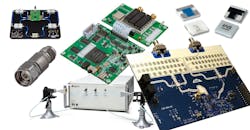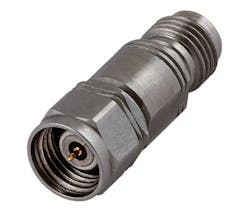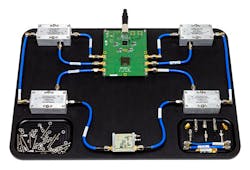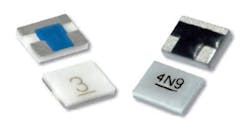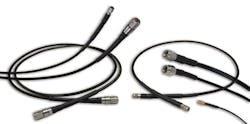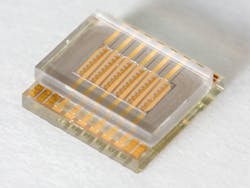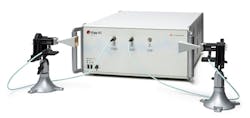IMS 2018 Prologue: Prepping for the mmWave Era
Download this article in PDF format.
Heightened interest in millimeter-wave (mmWave) frequencies was in evidence throughout the exhibit floor of the recent 2018 IEEE International Microwave Symposium (IMS). Thousands of visitors came to the Pennsylvania Convention Center (Philadelphia, Pa.) to visit display booths and representatives from hundreds of RF/microwave companies, with more companies than ever before showing products at frequencies of 28 GHz and beyond.
The companies worked under the shadows of large signs showing the now familiar “5G,” in anticipation of the fifth generation of wireless-network communications technology. 5G wireless networks will work at frequencies below 6 GHz, but will also use mmWave frequency bands at 28 GHz, 39 GHz, and higher for short-haul, high-speed data links. In addition, almost all commercial (and many military) autonomous “self-driving” vehicles will be loaded with mmWave components, devices, and circuits in the form of front- and rear-looking radar systems as part of advanced driver assistance systems (ADAS)
The 2018 IMS Conference and Exhibition was relatively upbeat, despite the industry’s earlier loss of one of its great leaders and innovators, Harvey Kaylie, the founder of Mini-Circuits. The RF/microwave industry is very much a close-knit community, and its members honored the life and many accomplishments of Harvey Kaylie by remembering him in their thoughts and pushing ahead in pursuit of advances and progress as he would have wished. The strong foundation established at Mini-Circuits was apparent by the large number of visitors to the company’s exhibition booth in search of good-quality products at low prices.
As with many companies at the 2018 IMS exhibition, Mini-Circuits has been seeking to push the upper-frequency limits of some of its components into the millimeter-wave range. Examples of these higher-frequency components were available at the booth, such as coaxial fixed attenuators and terminations operating well into the mmWave range. For example, precision fixed coaxial attenuators in the BW-E Series (Fig. 1) are available with attenuation values of 3, 6, 10, and 20 dB and attenuation accuracy of ±1.5 dB or better over a continuous frequency range of dc to 65 GHz. The RoHS-compliant attenuators are equipped with 1.85-mm connectors.
1. The BW-E Series fixed attenuators are available with attenuation values of 3, 6, 10, and 20 dB from dc to 65 GHz. (Courtesy of Mini-Circuits)
Visitors to Mini-Circuits’ booth may have also been surprised by the demo of a new product, the UVNA-63 (Fig. 2). It’s the first in a series of University Kits that provide students with a chance to build their own systems. This model is for a microwave transceiver that can be used as part of a vector network analyzer (VNA) with a frequency range from 500 to 6000 MHz and support for different software environments. Users have access to all components and interconnections to simplify adjustments and calibrations.
2. The UVNA-63 is a kit for creating a practical VNA for 500 to 600 MHz. (Courtesy of Mini-Circuits)
One of the truly stalwart suppliers of mmWave components, Sage Millimeter, was visible on the exhibition floor with both coaxial and waveguide components and test equipment in support of mmWave applications. One of the industry’s longest-running developers and suppliers of such products, the firm drew visitors to its booth with products such as direct-reading variable attenuators reaching as high as 220 GHz. Sage’s array of microwave through mmWave antennas is truly impressive, available in almost every configuration, from microstrip patches to sector antennas, lens antennas, and rectangular horns.
In addition to presenting an impressive array of components at RF through millimeter-wave frequencies, Pasternack explained its growing role in fulfilling needs for high-reliability hardware for commercial, industrial, and military applications. Visitors also had a chance to learn more about the company’s connection to software, in particular, its Pasternack Cable Creator, available on the firm’s website. It allows users to customize their cable and connector orders and even receive same-day shipping service for specialized, high-reliability cables and connectors, choosing from thousands of different connectors and hundreds of different cable types.
Antenna suppliers followed the industry trend of making higher-frequency products for mmWave applications. Flann Microwave showed its Series 240 standard gain horns, with waveguide models available for coverage at microwave frequencies from 1.14 to 1.75 GHz and extending to frequencies as high as 217 to 330 GHz. Visitors to the Flann Microwave booth were intrigued by the firm’s direct-reading Series 100 rotary attenuators, which also worked well into the mmWave range. Using waveguide connectors, models were available to 500 GHz with attenuation levels from 0 to 60 dB and attenuation accuracy of 1% or better.
San-tron showed its wide range of military-grade cable assemblies, including its SRX low-PIM cable assemblies and coaxial adapters for test and other critical applications. With intermodulation levels as low as −168 dBc (depending on cable and connector types), these cable assemblies are essential components for in-building wireless communications systems and distributed antenna systems (DAS).
Make It Smaller
As part of the continuing trend of designing and manufacturing smaller and ligher microwave components, Quest Microwave showed how smaller components could also handle relatively large amounts of input power without overheating.
As an example, Quest’s D38-M1720C01 four-port isolator/circulator is a drop-in component measuring just 1.50 × 0.75 × 0.25 in., but capable of handling as much as 10 W CW power from 1.7 to 2.0 GHz. With maximum VSWR of 1.25:1 and maximum insertion loss of 0.4 dB, the device is designed for operating temperatures from −30 to +70°C. Yet, the company also makes larger, standard and custom coaxial and waveguide isolators/circulators for commercial and military applications through 40 GHz.
In terms of miniaturized antennas, few companies can match Anokiwave and its wide range of IC antennas for commercial and military applications. The firm showed its active antenna phased-array antenna ICs for microwave and mmWave applications, including for satellite communications (satcom) and 24/26-, 28-, and 37/39-GHz antenna ICs aimed at 5G applications. In terms of commercializing antenna ICs at mmWave frequencies, the company’s founder and CEO, Dr. Nitin Jain, explained, “Anokiwave has over a decade of experience designing silicon mmWave active antenna ICs and is enabling the commercialization of mmWave active antennas with silicon ICs.”
Boeing exhibited at the IMS, but perhaps not in the way that most people would have expected: On display were analog, digital, and mixed-signal ICs and custom ASIC design assistance in a wide range of semiconductor technologies. Boeing’s Solid-State Electronics Development (SSED) organization performs work for commercial, military, and aerospace customers, with experience in technologies that include CMOS, GaAs, GaN, and SiGe processes. The firm’s ASIC engineers specialize in the design of semiconductors for harsh environments, including power supplies for temperatures from −55 to +225°C and a wide range of RF/microwave active and passive components through 44 GHz.
Atlanta Micro displayed its chip-sized RF/microwave components, including miniature passive components such as analog-tuned filters and filter banks to 26 GHz in surface-mountable QFN packages. As examples, model AM3060 is a digitally tunable filter for 400 to 6000 MHz in a 12.5- ×12.5-mm QFN package, while model AM3025A is a fixed-band filter bank for 400 to 6000 MHz in a 9- × 9-mm QFN. The firm also showed miniature heterodyne tuners for receive and transmit functions from 2 MHz to 12 GHz with 80-MHz bandwidths and receive functions from 100 MHz to 18 GHz and 500-MHz bandwidths.
Smiths Interconnect had several new product announcements at the 2018 IMS, including the release of its SpaceNXT HC Series high-reliability chip attenuators for commercial space applications (Fig. 3). With component failure not a realistic option for space-based systems, these cost-effective attenuators are fully tested for full mission assurance. Available in both fixed and temperature-variable versions for use from dc to 18 GHz, the surface-mountable components are totally passive for ease of installation. In fact, the temperature-variable attenuators can combine attenuation and level setting with temperature compensation to further shrink a PCB design.
3. The SpaceNXT HC Series high-reliability chip attenuators have been developed for commercial space applications from dc to 18 GHz. (Courtesy of Smiths Interconnect)
Smiths Interconnect also introduced its SpaceNXT Q series of flexible coaxial-cable assemblies at the exhibition. The cable assemblies are tested and qualified for space orbit applications. The cost-effective cable assemblies (Fig. 4) can be cut to customer-specified lengths for use from dc to 40 GHz (depending on connectors). They can meet NASA/ESA outgassing requirements when tested to ASTM E595 standards.
4. The SpaceNXT Q series of flexible coaxial cable assemblies are qualified for space applications from dc to 40 GHz. (Courtesy of Smiths Interconnect)
Even power-amplifier suppliers, such as Empower RF, have worked to shrink the size of its products, and its designers have been facing the challenges of higher output power levels from smaller volumes by boosting efficiency and enhancing thermal management. Using both LDMOS and GaN active devices, the company developed more compact power amplifiers for a variety of applications, including communications, radar, electronic warfare (EW), and testing.
A company long-synonymous with high-frequency switching, Dow-Key Microwave, displayed a sampling of its wide range of coaxial, waveguide, and space-qualified switches in many different configurations, from tiny drop-in components to rugged rack-mount matrices for testing. Part of the Dover companies (including K & L Microwave and Pole Zero) exhibiting at the 2018 IMS, Dow-Key offered advice on the use of its many different switches for RF through mmWave frequencies. Many visitors showed interest in lines of low passive-intermodulation (PIM) switches. These are growing in importance due to the greater number of carriers in communications systems, which increases the potential for intermodulation distortion.
Similarly, Krytar, a name very much connected to RF/microwave couplers, was on hand at the 2018 IMS exhibition with examples of its now extensive line of directional couplers, detectors, and hybrids, including its latest space-qualified coupler, model 101040010SQ. This broadband, 1- to 40-GHz directional coupler with 10-dB coupling remains flat within ±1 dB across the frequency range. The stripline coupler has less than 1.3-dB insertion loss to 20 GHz and less than 1.7-dB insertion loss through 40 GHz. Given the space-based need for small-sized, lightweight components, the coupler measures just 2.00 × 0.40 × 0.65 in. and weighs just 1.3 oz.
SemiGen impressed visitors not familiar with the company with the diversity and quality of its services, ranging from RF/microwave circuit design and PCB assembly to extensive high-frequency testing at component through system levels. With experience in many different board-assembly methods, including wire and ribbon bonding and die-attach techniques for circuits through millimeter-wave frequencies, the firm can produce RF, microwave, mmWave, digital, and mixed-signal PCBs from single- to multiple-layer configurations, and perform full electrical and environmental testing on all manufactured parts.
Modularity
Many modular solutions were in evidence at the 2018 IMS exhibition. For example, Ancortek demonstrated the benefits of software-defined-radio (SDR) technology with various low-power, lightweight radio systems for S-, C-, X-, and K-band frequencies targeting applications like medical diagnosis and public safety.
The firm also showed examples of kits based on its SDR modules, such as a kit with its 240B SDR module and SDR-PM 402 processor module (Fig. 5). The S-band (2.45 GHz) kit makes it easy to get started in SDR technology. It includes both modules, a power supply/adapter, USB and RF cables, a copy of the firm’s SDR graphical user interface (GUI) software, and a pair of transmit and receive antennas.
5. This 2.45-GHz kit makes it easy to get started with SDR technology. (Courtesy of Ancortek)
Colorado Engineering brought its expertise in compact module design to the exhibition, demonstrating its iScan Radar Series modules (Fig. 6) for land, sea, and air environments. Available with 24-, 60-, and 77-GHz options, the modules can measure range, speed, and radar cross section (RCS) with their steerable beams and digital-beamforming capabilities.
6. The iScan Radar Series modules are miniature radar system modules with options for 24, 60, and 70 GHz. (Courtesy of Colorado Engineering)
Polyphase Microwave demonstrated a PXIe block frequency up/downconverter system with models for C-band (4 to 8 GHz) and X-band (8 to 12 GHz) frequencies. Well-suited for use in vector signal transceivers and Doppler weather radar systems, the modular system features automatic local-oscillator (LO) feedthrough calibration and as much as 30-dB signal attenuation in 1-dB steps. The miniature frequency converter includes an internal phase-locked-loop (PLL) LO frequency synthesizer and is capable of 1-GHz in-phase/quadrature (I/Q) bandwidth. It operates with a standalone control panel and software.
More About Materials
Materials of many kinds caught the attention of 2018 IMS visitors, especially at the Menlo Micro booth, where many different microelectromechanical-systems (MEMS) switches could be found, including the latest miniature six-channel switch fabricated on pristine dielectric glass wafers from Corning. The outstanding dielectric properties of the glass substrates made possible a miniature MEMS switch with high power-handling capabilities (25 W CW) from dc to 3 GHz despite its semiconductor-chip size (Fig. 7).
7. By teaming with glass-maker Corning, Menlo Micro fabricated this tiny six-channel SPST MEMS switch on a glass substrate. (Courtesy of Menlo Micro)
In addition to showing what it could do on glass, representatives from Menlo Micro also demonstrated the performance of some more-established MEMS components—essentially semiconductor-sized mechanical devices activated by applied voltages. For example, the MM7100 high-power MEMS switch handles 100 W CW input power from dc to 750 MHz with 8-µs switching time in a compact low-temperature-cofired-ceramic (LTCC) package. For higher frequencies, model MM5120 is a SP4T switch that handles more than 25 W CW input power from dc to 12 GHz and comes in a surface-mount package.
RO4835T laminates on display by Rogers Corp. are circuit materials reinforced by spread glass. These thin (3-, 4-, or 5-mil-thick) thin layers are well suited for the inner layers of multiple-layer circuit assemblies, where they can provide high-frequency circuit functionality without adding to the overall height of the circuit assembly. Newly launched RO4450T thin bonding materials were also exhibited at the Roger’s IMS booth, as a complement to RO4835 and RO4835T laminates for creating multilayer circuit assemblies.
Rogers showed many of its high-frequency circuit materials, including some formulated especially to meet the demands of mmWave antennas needed for ADAS vehicular applications.
The firm’s low-loss circuit laminates, such as RO3000 and RO4000 materials, are already well-established in automotive collision-avoidance radar systems at 28 and 77 GHz. Its RT/duroid 6035HTC laminates (Fig. 8) caught the eyes of many circuit designers in need of materials with excellent thermal conductivity to control the heat generated by high-power amplifiers.
8. Due to its excellent thermal conductivity, RT/duroid 6035HTC laminates are popular circuit materials for high-power RF/microwave amplifiers. (Courtesy of Rogers Corp.)
Rogers also showed its Kappa 438 materials, which are the thin-but-durable circuit materials needed for more reliable alternatives to FR-4 laminates. These new materials piqued the interest of circuit designers working on carrier-grade Wi-Fi circuits, small cells, and vehicle communications.
With its I-Tera MT40 low-loss circuit material, representatives from Isola Group advised circuit designers on both high-speed digital and RF/microwave circuits. The material, with low dissipation factor of 0.0031, exhibits a dielectric constant of 3.45 that remains stable with operating temperatures from −55 to +125°C. Available in laminate and prepreg forms, the RoHS-compliant circuit material supports circuit designs to W-band (75 to 110 GHz) frequencies as a foundation for 5G and ADAS automotive radar circuits.
Get Ready for 5G
This was an IMS exhibition dominated by designs and solutions intended for 5G applications. LitePoint, for example, showed its iQgig-5G fully integrated 5G millimeter-wave test system for 5G measurements at 28 and 39 GHz. The system provides three bidirectional source and measurement ports each with 2.92-mm coaxial connectors. The configuration enables both horizontal and vertical antenna polarization testing with a single coaxial interface. The test set (Fig. 9) features error-vector-magnitude (EVM) performance to 40 dB and a 1-GHz bandwidth to cover pre-5G and 3GPP cellular/wireless standards. It can be equipped with a 3GPP NR 5G software license as well as a Verizon 5G Technical Forum (5gTF) license.
9. Model iQgig-5G is a mmWave test system for 5G measurements at 28 and 39 GHz. (Courtesy of LitePoint)
In addition to showing its trusted benchtop test equipment, Anritsu’s representatives spent a great deal of time with a pocket-sized solution: the model MS2760A Spectrum Master spectrum analyzer. Available with a frequency range as wide as 9 kHz to 110 GHz, this portable measurement marvel can be brought to the device under test (DUT), rather than the other way around. It’s ideal for on-site 5G measurements of channel power and occupied bandwidth. And the analyzer has the frequency range to detect and measure other RF sources in the area, such as wireless local-area networks (WLANs) and Bluetooth devices, as well as possible interference signals from mmWave automotive radar systems.
The MS2760A Spectrum Master (Fig. 10) has a displayed average noise level (DANL) as low as −136 dBm and a dynamic range of better than 103 dB, to capture low-level signals in many different environments. But as visitors to the Anritsu booth learned, don’t let the small size fool you. With its low phase noise and resolution bandwidths of 1 Hz through 1 MHz, this instrument is a match for any rack-mount spectrum analyzer on the market, especially when it comes time to track down rogue mmWave signals.
10. The MS2760A Spectrum Master is a full-featured spectrum analyzer that operates from 9 kHz to 110 GHz and fits in the palm of the hand. (Courtesy of Anritsu)
In preparation for 5G, pSemi Corp. (formerly Peregrine Semiconductor) displayed several miniature mmWave components, including a pair of switches for 40 and 50 GHz and a 50-GHz digital step attenuator (DSA). The 6-b model PE43508 DSA operates from 9 kHz to 50 GHz with as much as 31.5-dB attenuation in 0.5- and 1-dB steps. The DSA, with impressive switching speed of typically 350 ns, is available as a flip-chip monolithic die. The company also announced an evaluation kit for the DSA to speed designers in the use of the tiny attenuator.
Seeking Software
Software users found much to like at the 2018 IMS, with all of the leading suppliers of high-frequency software design and simulation tools in attendance on the exhibition floor. Visitors to the Sonnet Software exhibition booth learned more about Version 16 of the company’s popular Sonnet Suites software design and analysis tools, including Sonnet Professional electromagnetic (EM) simulation software. This latest version includes a high-resolution (64-b) interface to another popular suite of RF/microwave software design tools, Microwave Office from NI AWR. The enhancement of existing functions such as adaptive band synthesis (ABS) in Version 16 enables the software to simulate the presence of circuit resonances and other performance characteristics.
Antenna designers passing the Remcom booth saw demonstrations of the Wireless InSite MIMO software, which will no doubt see plenty of action during the erection of 5G wireless networks. The software helps in the design of MIMO antenna arrays by simulating many MIMO channels and their interactions. It can model beamforming scenarios and spatial multiplexing effects, as well as perform three-dimensional (3D) ray tracing to 100 GHz to predict antenna patterns and signal-path characteristics between transmitters and receivers in 5G networks.
For amplifier designers and others interesting in achieving effective impedance matches between active devices and surrounding circuitry, Focus Microwaves showed examples of its electromechanical source and load-pull tuners, including its Omega tuner for 5G applications. The tuner features a small footprint for on-wafer testing, and is light weight for ease of transport. It operates through mmWave frequencies (67 GHz) with 1.85-mm connectors and can handle power levels to 14 W. The firm also showed its M-67100 DELTA tuners for harmonic on-wafer load-pull measurements through 67 GHz.
In general, visitors to the 2018 IMS were enthusiastic about business prospects for the future, based on healthy markets expected for 5G and autonomous vehicles, especially at mmWave frequencies. In addition, defense spending is still strong, and exhibitors and visitors alike acknowledged the continuing needs for product and technology improvements aimed at aerospace and defense applications.
About the Author
Jack Browne
Technical Contributor
Jack Browne, Technical Contributor, has worked in technical publishing for over 30 years. He managed the content and production of three technical journals while at the American Institute of Physics, including Medical Physics and the Journal of Vacuum Science & Technology. He has been a Publisher and Editor for Penton Media, started the firm’s Wireless Symposium & Exhibition trade show in 1993, and currently serves as Technical Contributor for that company's Microwaves & RF magazine. Browne, who holds a BS in Mathematics from City College of New York and BA degrees in English and Philosophy from Fordham University, is a member of the IEEE.
